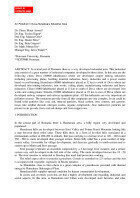Air Pollution in Deva-Hunedoara Industrial Area
Oct 06 2014
Author: Dr. Chem. Matei Aronel, Dr. Eng. Traista Eugen, Drd. Eng. Madear Gelu, Dr. Eng. Hodor Petru, Dr. Eng. Buia Grigore, Dr. Math. Mitran Ilie and Manager Eng. Jurca Traian on behalf of CEM
ABSTRACT: In central part of Romania there is a very developed industrial area. This industrial area consist of a great number of industrial companies developed in three cities. In this area are the following cities: Deva (80000 inhabitants) where are developed cooper mining industries including processing plants, building material industries, heavy industries and a power station based on coal burning; Hunedoara (80000 inhabitants) placed at 12 km to south of Deva where are developed iron mining industries, iron works, coking plants, manufacturing industries and heavy industries; Cãlan (10000 inhabitants) placed at 15 km to south of Deva where are developed ironworks and coking plants; Simeria (10000 inhabitants) placed at 10 km to east of Deva where are developed railway transport and railway equipment plant. All this industries are very important air pollution sources. The emissions provide from all this companies are very complex. In air could be found solid particles like coal, ash, mineral particles, black carbon, iron, cement, and gaseous noxes like sulphur dioxide, nitrogen oxides, organic compounds. Also radioactive particles are present in air provide from coal ash dumps and from copper ores.
1 INTRODUCTION
In the central part of Romania there is Hunedoara area, a hilly region very developed and populated.
Hunedoara hills are developed between Strei Valley and Poiana Ruscã Mountain looking like a step between these relief units. These hills show in a form of levelled hills associated in a piemountain surface at 400-450 m altitude, that pass outlying to a terrace level at 140 - 160 m and 350 - 360 m, more developed than younger terrace. Entire hilly relief has a great number of large source valley, favourable for village development, and decrease gradually to north-eastern and to eastern up to Mures and Strei passage.
Strei passage represent an ensemble compound by a 3 km large river meadow and a terrace system very well developed in the left side of the valley. The more developed terrace has 18 - 20m. The river meadow is subjected to flooding that need land protection working.
The relief aspect allow to practice agriculture. Cereals is extended on 2/3 surface and the rest is occupied with vegetable, especially in Mures meadow.
At Sântuhalm, close to Deva there is a great complex of greenhouses provided with thermal energy by Hunedoara Siderurgical Plant.
Hunedoara hills supplies optimal condition for human communities development.
In sixties and seventies years this are had a highly development rate regarding industrial and social aspects. In this area, at Hunedoara and Cãlan were developed steel factories and coke plants. Today this area supply 1/5 from Romanian steel. This development based on local iron ores reserves from Poiana Ruscã Mountain, coke coal from Jiu Valley and an over one hundred years tradition.
In eighties years the industrial development based on diversification including building materials industry, food industry and light industry. At Hunedoara was built a 12 MW power station based on coke oven gas and a similar one at Cãlan.
Building materials industry is based on local resources and siderurgical waste. Building materials plants are to Chiscãdava close to Deva and to Bârcea Micã close to Hunedoara. Marble is manufactured also to Simeria and talc powder, dolomite and lime to Hunedoara.
Light industry and food industry is based on a great number of small capacities. At Hunedoara was built a shoes factory and a woollen knitted factory and at Deva a silk factory. Preserved meat and milk processing factories are developed at Deva, Hunedoara and Simeria.
Since 1980 Deva became an industrial city, approaching with Hunedoara and Cãlan specific industry, very strong developed and very pollutant.
Industrial development affected environment and its equilibrium state mainly by air and water pollution especially in developed cities area. The most polluted area is represented by Hunedoara where the industrial zone have a large number of polluting sources (16).
The inherited relation between industrial area and residential area that expose the whole communities to a high pollution exposure process, increase in the last years. In comparison with the initial report the urbanisation rate increase continuously. The vicinity report between industrial and residential area cannot assure the required protection spaces between high polluted industrial area and residential area.
Digital Edition
Asian Environmental Technology 27.2 - April/May 2023
May 2023
In This Edition Business News - Celebrating The Life Of A Gas Measurement Industry Icon - A New Home For Gas Sensor Specialists - Envea Completes The Acquisition Of Hycontrol Ltd Environ...
View all digital editions
Events
Jul 02 2023 Albena, Bulgaria
Jul 04 2023 Cardiff, UK
Jul 05 2023 Johannesburg, South Africa
Jul 11 2023 Shanghai, China
Jul 11 2023 Lagos, Nigeria















